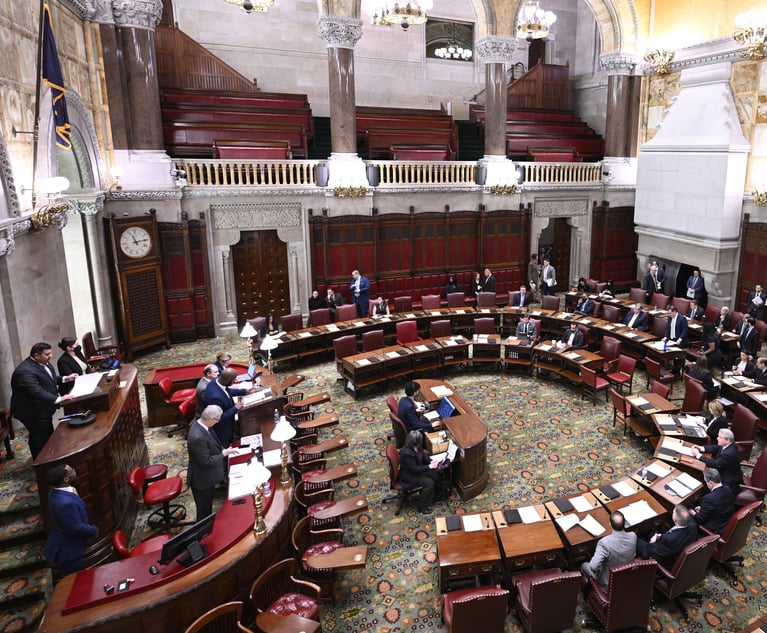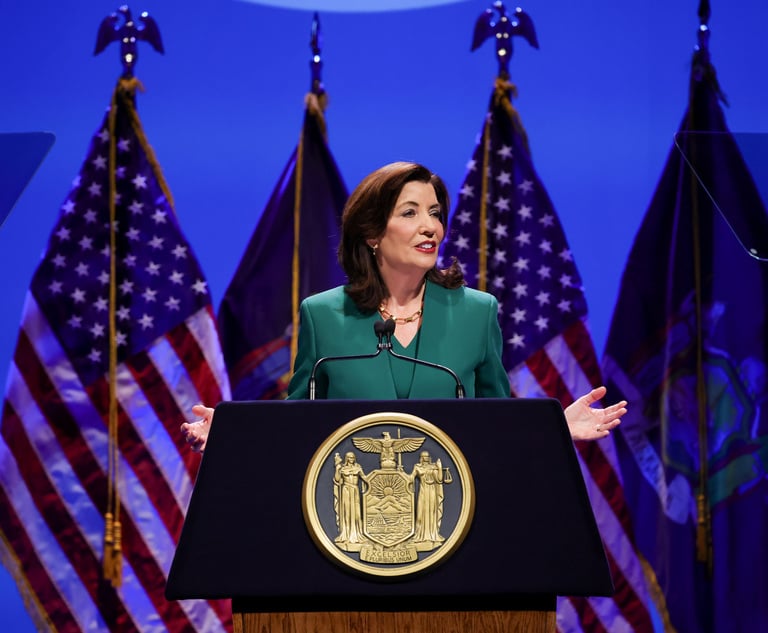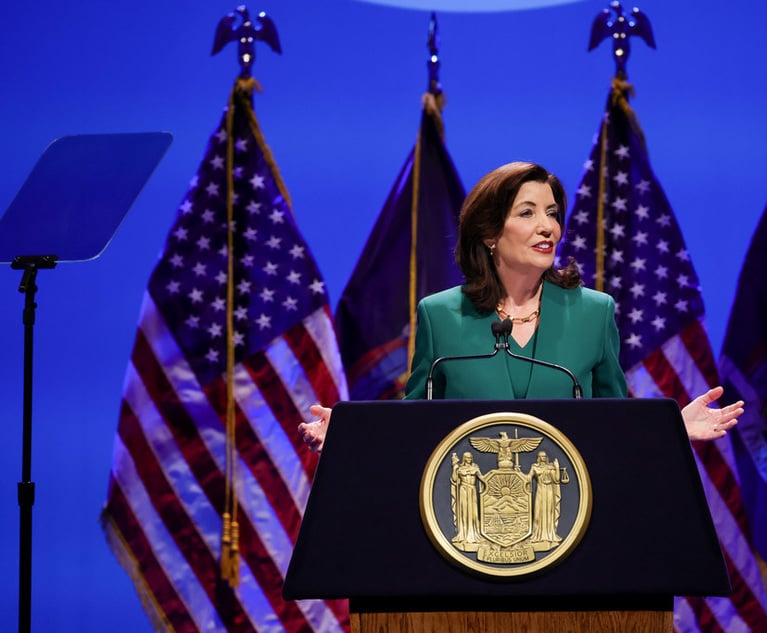DiFiore's Trial Court Restructuring Plan Draws Opposition From Justices' Group
The proposal is intended to simplify the state's trial court system, which some have said is difficult to navigate for litigants, particularly when more than one venue is involved in a particular case. But critics focused on the "unbridled discretion" court administrators would have to shuffle judges around the state.
October 08, 2019 at 02:34 PM
7 minute read
 Chief Judge Janet DiFiore speaks at the Justice For All luncheon at the New York State Bar Association Annual Meeting on Jan. 25. Photo: David Handschuh/NYLJ.
Chief Judge Janet DiFiore speaks at the Justice For All luncheon at the New York State Bar Association Annual Meeting on Jan. 25. Photo: David Handschuh/NYLJ.
Chief Judge Janet DiFiore's plan to overhaul the complex system of low-level trial courts in New York now has at least one major opponent after a trade group representing the state's Supreme Court justices announced their opposition to the proposal late Monday.
The Association of Justices of the Supreme Court of the State of New York argued in a press release that the plan would diminish the power of voters to select local judges.
"The proposal removes the power of citizens to meaningfully select the judges in their communities who will decide, for example, family matters, or probate disputes, or criminal cases, or general civil disputes, and vests this fundamental constitutional right in the hands of administrators," the group wrote.
That's because, they wrote, DiFiore's plan would eliminate many of the state's 11 specialized trial courts, the lowest level, and consolidate them and their justices into three major sections.
Many of those judges are currently elected by voters. Justices of the Family Court outside New York City, for example, are chosen that way. Others, like justices of the Court of Claims, are appointed to the bench.
DiFiore's plan would merge that system into a new one, where many of those justices would give up their previous positions and serve on a newly expanded state Supreme Court, which, despite its name, is on the lowest tier of the state judiciary.
The second section, called the Municipal Court, would be formed by consolidating the more localized courts in the state's major cities, including New York City. Town and village courts would make up the third section and wouldn't be changed by the plan.
The proposal is intended to simplify the state's trial court system, which some have said is difficult to navigate for litigants, particularly when more than one venue is involved in a particular case.
But critics focused on the "unbridled discretion" court administrators would have to shuffle judges around the state.
Under the current way the judiciary is set up, a survivor of domestic violence may have to attend criminal court proceedings for the charges against their alleged abuser and have a separate case in civil court to finalize their divorce.
A spokesman for the state Office of Court Administration said the arguments from the AJSCSNY were a result of the group's "self-interest," and said the benefits of the consolidation proposal would far outweigh their concerns.
"The objections raised by the Supreme Court Justices Association are focused on self-interest," said Lucian Chalfen, the OCA spokesman. "The Association has not addressed the many benefits that flow from simplifying a complicated outdated court structure."
The AJSCSNY argued that the state's current plethora of trial courts should be seen as an advantage, showcasing the specialized attention that litigants receive in each venue, rather than a complicated process for unique cases.
"New York's tapestry of courts provides both a sophisticated court of general jurisdiction—the Supreme Court—as well as other discrete courts of limited jurisdiction created to accomplish their own important specialized work," the group wrote. "This is a reflection of the volume, complexity and diversity of cases coming to the courts."
Under DiFiore's plan, the state Court of Claims, County Courts, Family Courts and Surrogate's Courts would all be eliminated. The justices who served on those courts would remain and become state Supreme Court justices.
Their titles would change, but the length of their terms and the way they're selected would not. The judicial position once held by a Family Court justice would still have a 10-year term, for example, and would still be filled through an election.
The problem with that, the AJSCSNY argued, is that the proposal would then allow the state Office of Court administration to place those judges in whatever role they see fit.
DiFiore's plan would divide the state Supreme Court into six divisions: family, probate, criminal, state claims, commercial and general.
But, unlike the current system, neither voters nor the individuals who currently appoint judges, like the governor, would decide where those jurists are placed. That would be up to court administrators, which the AJSCSNY took particular issue with.
"Under the guise of this 'simplification,' the proposal would accord OCA the unbridled discretion to alter these divisions and move judges around the court system wherever it wants, whether for appropriate or inappropriate reason," the group wrote.
Chalfen, the OCA spokesman, said court administrators were confident judges could successfully take on a wider breadth of cases under the reform plan. That method is already mirrored in the federal judiciary, he said.
"While there is no need to respond to all of the Association's assertions, we note that federal judges preside over every category of litigation that is assigned," Chalfen said. "There is no reason to believe that New York's Judges cannot perform with the same competence as their colleagues on the Federal Bench."
The AJSCSNY questioned, as an example of their concerns, how DiFiore's plan would affect the state's recently enacted Raise the Age law, which bars individuals under the age of 18 from being treated as adults in the state's criminal justice system.
That law currently requires that 16- and 17-year-olds appear in a specialized Youth Part of the Criminal Court, where their cases are either adjudicated or transferred to Family Court. Most cases have been sent to Family Court since the law took effect last year, state data shows.
The state Legislature created that mechanism to ensure that criminal cases against children are treated differently than those of adults. It's unclear how DiFiore's plan would change that scheme, the AJSCSNY wrote.
The group also claimed that DiFiore's plan would cost the state money. They said accounting firm KPMG set a price tag of $38 million for a similar idea proposed in 1987, which would translate to more than double that amount in today's dollars.
Chalfen said that prediction "is dated and based on inaccurate information."
A commission convened in 2007 by former Chief Judge Judith Kaye, an outspoken supporter of consolidating the state's trial courts, found a different result. That panel, in its final report, found that a similar proposal could save the state approximately $500 million each year.
DiFiore's plan hasn't received such an analysis since it was formally proposed two weeks ago. At least one public hearing has been scheduled by members of the Legislature to review the proposal, at which lawmakers have said they plan to bring up the topic of cost.
The hearing is scheduled for Nov. 13 in New York City, according to lawmakers.
READ MORE:
NY Lawmakers Set to Hold First Hearing on DiFiore's Trial Court Reform Plan
DiFiore Unveils Detailed Proposal for Lawmakers to Overhaul New York's Trial Courts
NY Lawmakers See Court Reform, Assigned Counsel Rate Hike With Favor
DiFiore Renews Call for Lawmakers to Restructure NY Court System
Report Argues Town and Village Justices Ignore Plight of Poor Defendants Facing Fines
This content has been archived. It is available through our partners, LexisNexis® and Bloomberg Law.
To view this content, please continue to their sites.
Not a Lexis Subscriber?
Subscribe Now
Not a Bloomberg Law Subscriber?
Subscribe Now
NOT FOR REPRINT
© 2025 ALM Global, LLC, All Rights Reserved. Request academic re-use from www.copyright.com. All other uses, submit a request to [email protected]. For more information visit Asset & Logo Licensing.
You Might Like
View All
Relaxing Penalties on Discovery Noncompliance Allows Criminal Cases to Get Decided on Merit
5 minute read
Bipartisan Lawmakers to Hochul Urge Greater Student Loan Forgiveness for Public-Interest Lawyers

'Playing the Clock'?: Hochul Says NY's Discovery Loophole Is to Blame for Wide Dismissal of Criminal Cases

So Who Won? Congestion Pricing Ruling Leaves Both Sides Claiming Victory, Attorneys Seeking Clarification
4 minute readTrending Stories
- 1New York-Based Skadden Team Joins White & Case Group in Mexico City for Citigroup Demerger
- 2No Two Wildfires Alike: Lawyers Take Different Legal Strategies in California
- 3Poop-Themed Dog Toy OK as Parody, but Still Tarnished Jack Daniel’s Brand, Court Says
- 4Meet the New President of NY's Association of Trial Court Jurists
- 5Lawyers' Phones Are Ringing: What Should Employers Do If ICE Raids Their Business?
Who Got The Work
J. Brugh Lower of Gibbons has entered an appearance for industrial equipment supplier Devco Corporation in a pending trademark infringement lawsuit. The suit, accusing the defendant of selling knock-off Graco products, was filed Dec. 18 in New Jersey District Court by Rivkin Radler on behalf of Graco Inc. and Graco Minnesota. The case, assigned to U.S. District Judge Zahid N. Quraishi, is 3:24-cv-11294, Graco Inc. et al v. Devco Corporation.
Who Got The Work
Rebecca Maller-Stein and Kent A. Yalowitz of Arnold & Porter Kaye Scholer have entered their appearances for Hanaco Venture Capital and its executives, Lior Prosor and David Frankel, in a pending securities lawsuit. The action, filed on Dec. 24 in New York Southern District Court by Zell, Aron & Co. on behalf of Goldeneye Advisors, accuses the defendants of negligently and fraudulently managing the plaintiff's $1 million investment. The case, assigned to U.S. District Judge Vernon S. Broderick, is 1:24-cv-09918, Goldeneye Advisors, LLC v. Hanaco Venture Capital, Ltd. et al.
Who Got The Work
Attorneys from A&O Shearman has stepped in as defense counsel for Toronto-Dominion Bank and other defendants in a pending securities class action. The suit, filed Dec. 11 in New York Southern District Court by Bleichmar Fonti & Auld, accuses the defendants of concealing the bank's 'pervasive' deficiencies in regards to its compliance with the Bank Secrecy Act and the quality of its anti-money laundering controls. The case, assigned to U.S. District Judge Arun Subramanian, is 1:24-cv-09445, Gonzalez v. The Toronto-Dominion Bank et al.
Who Got The Work
Crown Castle International, a Pennsylvania company providing shared communications infrastructure, has turned to Luke D. Wolf of Gordon Rees Scully Mansukhani to fend off a pending breach-of-contract lawsuit. The court action, filed Nov. 25 in Michigan Eastern District Court by Hooper Hathaway PC on behalf of The Town Residences LLC, accuses Crown Castle of failing to transfer approximately $30,000 in utility payments from T-Mobile in breach of a roof-top lease and assignment agreement. The case, assigned to U.S. District Judge Susan K. Declercq, is 2:24-cv-13131, The Town Residences LLC v. T-Mobile US, Inc. et al.
Who Got The Work
Wilfred P. Coronato and Daniel M. Schwartz of McCarter & English have stepped in as defense counsel to Electrolux Home Products Inc. in a pending product liability lawsuit. The court action, filed Nov. 26 in New York Eastern District Court by Poulos Lopiccolo PC and Nagel Rice LLP on behalf of David Stern, alleges that the defendant's refrigerators’ drawers and shelving repeatedly break and fall apart within months after purchase. The case, assigned to U.S. District Judge Joan M. Azrack, is 2:24-cv-08204, Stern v. Electrolux Home Products, Inc.
Featured Firms
Law Offices of Gary Martin Hays & Associates, P.C.
(470) 294-1674
Law Offices of Mark E. Salomone
(857) 444-6468
Smith & Hassler
(713) 739-1250






